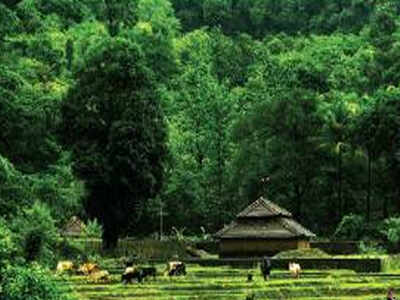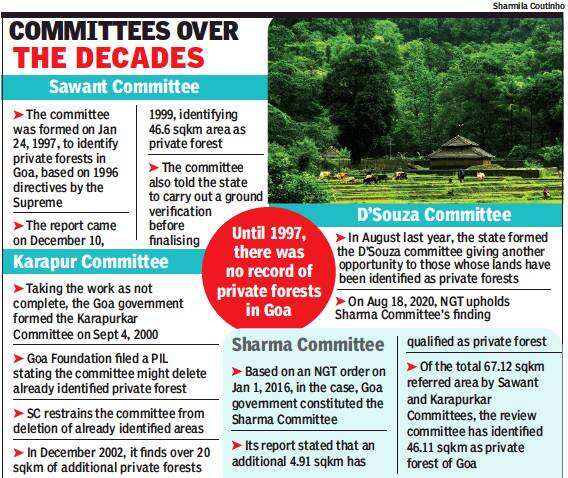
PANAJI: The National Green Tribunal’s (NGT) order asking the Goa government to notify 46.11 sq km as private forest has been the culmination of a decades-long struggle by environmentalists, to get the green cover outside of state domain preserved.
Once notified, the government will proceed to protect the private forest even as land owners have been strongly opposing the inclusion of their properties in ‘private forests’.

Starting as early as 1997, the state government found itself at odds with the court on several occasions, as it set up at least four different committees with varying outcomes in getting the private forest identified.
It is the 1996 directives of the Supreme Court in a writ petition that led Goa government to set up the Sawant Committee in January 1997 to identify private forests. The report was submitted by the committee two years later in December 1999.
The Sawant Committee, comprising forest officials, identified 46.6 sq km area as private forest. However, the Committee itself stated in its report that the state government would have to carry out actual ground verification before it can finalise the report on private forests.
The Sawant Committee also clarified that still more areas might have remained unidentified. Taking a cue from this, the Goa government maintained that many areas are yet to be identified, leading to the formation of another committee under Hemant Karapurakar in 2009.
It is this development, which triggered the long-drawn battle in the courts between Goa Foundation and the state.
In March 2001, Goa Foundation knocked on the doors of the Supreme Court. As per Goa Foundation, the state set up the Karapurkar Committee after being ‘prevailed upon by certain lobbies and vested interests’.
The Apex Court found Goa Foundation’s contention valid that the new committee might re-examine and delete some private forest survey numbers as identified in the Sawant Committee’s recommendations. The SC then ‘restrained the Karapurkar Committee or any other person or agency from interfering with the Sawant Committee’s report’.
Subsequently, the Karapurkar Committee submitted its report in December 2002, identifying additional 20.52 sq kms of private forests.
At this point both committees had identified over 67 sq km as private forests in Goa.
Just as the state was contemplating action of these two reports, the high court of Bombay at Goa in 2003 passed an order asking the state government to identify non-forest areas from forest areas on the basis of the Sawant and Karapurkar committees recommendations.
The exercise taken up by the forest department as a result took five years to complete. Yet again, Goa Foundation challenged this forest department report in the high court.
The same matter was then transferred by the high court to the NGT. In 2016, based on NGT’s order, the Sharma committee was formed. The state government formed yet another committee last year.
Finally, the NGT bench Sheo Kumar Singh and Satyawan Singh Garbayal said that since the matter has been pending since long and the matter has been surveyed, identified and demarcated more than 4 times, the matter should come to end.
The court then accepted the Sharma Committee report in toto.
Once notified, the government will proceed to protect the private forest even as land owners have been strongly opposing the inclusion of their properties in ‘private forests’.

Starting as early as 1997, the state government found itself at odds with the court on several occasions, as it set up at least four different committees with varying outcomes in getting the private forest identified.
It is the 1996 directives of the Supreme Court in a writ petition that led Goa government to set up the Sawant Committee in January 1997 to identify private forests. The report was submitted by the committee two years later in December 1999.
The Sawant Committee, comprising forest officials, identified 46.6 sq km area as private forest. However, the Committee itself stated in its report that the state government would have to carry out actual ground verification before it can finalise the report on private forests.
The Sawant Committee also clarified that still more areas might have remained unidentified. Taking a cue from this, the Goa government maintained that many areas are yet to be identified, leading to the formation of another committee under Hemant Karapurakar in 2009.
It is this development, which triggered the long-drawn battle in the courts between Goa Foundation and the state.
In March 2001, Goa Foundation knocked on the doors of the Supreme Court. As per Goa Foundation, the state set up the Karapurkar Committee after being ‘prevailed upon by certain lobbies and vested interests’.
The Apex Court found Goa Foundation’s contention valid that the new committee might re-examine and delete some private forest survey numbers as identified in the Sawant Committee’s recommendations. The SC then ‘restrained the Karapurkar Committee or any other person or agency from interfering with the Sawant Committee’s report’.
Subsequently, the Karapurkar Committee submitted its report in December 2002, identifying additional 20.52 sq kms of private forests.
At this point both committees had identified over 67 sq km as private forests in Goa.
Just as the state was contemplating action of these two reports, the high court of Bombay at Goa in 2003 passed an order asking the state government to identify non-forest areas from forest areas on the basis of the Sawant and Karapurkar committees recommendations.
The exercise taken up by the forest department as a result took five years to complete. Yet again, Goa Foundation challenged this forest department report in the high court.
The same matter was then transferred by the high court to the NGT. In 2016, based on NGT’s order, the Sharma committee was formed. The state government formed yet another committee last year.
Finally, the NGT bench Sheo Kumar Singh and Satyawan Singh Garbayal said that since the matter has been pending since long and the matter has been surveyed, identified and demarcated more than 4 times, the matter should come to end.
The court then accepted the Sharma Committee report in toto.

Coronavirus outbreak
Trending Topics
LATEST VIDEOS
City
 Government to charge higher aviation security fee from domestic and international passengers starting September 1
Government to charge higher aviation security fee from domestic and international passengers starting September 1  Chetan Bhagat breaks silence on Sushant Singh Rajput, names and shames B-Town bullies
Chetan Bhagat breaks silence on Sushant Singh Rajput, names and shames B-Town bullies  Dubai link, involvement of 'professional killers' in SSR death?
Dubai link, involvement of 'professional killers' in SSR death?  Survey paints grim picture, 53% Tamil Nadu households lost jobs amid lockdown
Survey paints grim picture, 53% Tamil Nadu households lost jobs amid lockdown
More from TOI
Navbharat Times
Featured Today in Travel
Quick Links
Kerala Coronavirus Helpline NumberHaryana Coronavirus Helpline NumberUP Coronavirus Helpline NumberBareilly NewsBhopal NewsCoronavirus in DelhiCoronavirus in HyderabadCoronavirus in IndiaCoronavirus symptomsCoronavirusRajasthan Coronavirus Helpline NumberAditya ThackerayShiv SenaFire in MumbaiAP Coronavirus Helpline NumberArvind KejriwalJammu Kashmir Coronavirus Helpline NumberSrinagar encounter
Get the app



